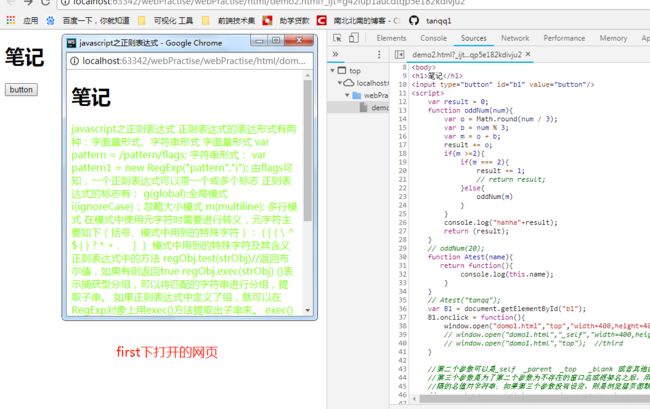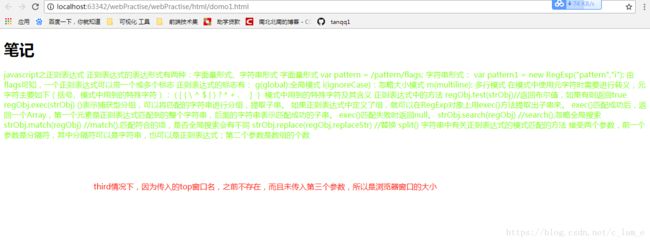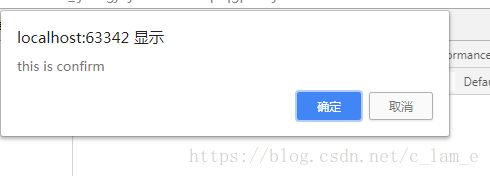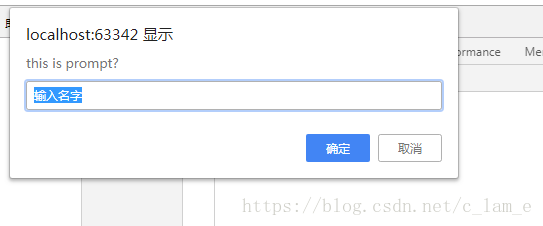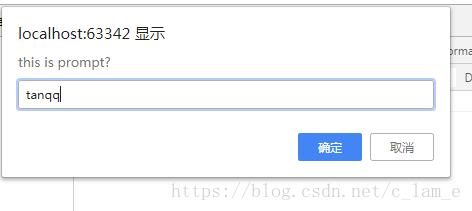- 转码日记——Javascript笔记(8)
zzcoding_
转码日记数据结构javascript前端开发语言
数组(Array)数组也是一个对象,和普通对象功能类似。普通对象使用字符串作为属性名,而数组使用数字来作为索引操作。索引:从0开始的整数。数组的存储效率比较高,对属性名没有要求的时候可以使用。基本应用//创建数组对象vararr=newArray();//向数组中添加对象//语法:数组[索引]=值;arr[0]=10;arr[1]=33;//如果读取不存在的索引则返回undefined//获取数组
- 转码日记——Javascript笔记(14)BOM对象
zzcoding_
转码日记javascript前端html5
BOM(browserobjectmodel)浏览器对象模型在BOM中,为我们提供了一组对象,用来帮助我们完成对浏览器的操作。BOM对象:Window(代表整个浏览器的窗口,同时也是网页中的全局对象),Navigator(代表当前浏览器的信息,通过该对象可以识别不同的浏览器),Location(代表当前浏览器的地址栏信息,可以获得地址栏信息并操纵浏览器跳转页面),History(代表浏览器的历史记
- JavaScript笔记/ES6常用语法(笔记)
joker731
ES6新增了let命令,用来声明变量。它的用法类似于var,但是所声明的变量,只在let命令所在的代码块内有效。for循环还有一个特别之处,就是设置循环变量的那部分是一个父作用域,而循环体内部是一个单独的子作用域。let命令改变了语法行为,它所声明的变量一定要在声明后使用,否则报错。ES6明确规定,如果区块中存在let和const命令,这个区块对这些命令声明的变量,从一开始就形成了封闭作用域。凡是
- Javascript笔记
nuomi_w
javascript前端html
1、什么是JavaScript1.1、概述JavaScript是一门世界上最流行的脚本语言Java、JavaScript=一个合格的后端人员,必须要精通JavaScript=1.2、历史https://www.w3school.com.cn/js/pro_js_history.aspECMAScript它可以理解为是JavaScript的一个标准最新版本已经到es6版本但大部分浏览器还只停留在支持
- JavaScript笔记整理
无所不能的蓝巨人
前端javascript
title:JavaScripttags:JavaScriptnotebook:JavaScript笔记整理1.JavaScript基础2022年3月18日大数据类型使用bigIntnull有数据位置但是没有数据,undefined是完全没有数据位置object{}对象,array[]数组if中如果没有写判断语句则括号中的内容会被转换成布尔类型(隐式转换)false:nullnuderfined0
- web前端javascript笔记——(14)Navigator 、History、Location
Komorebi_9999
前端javascript笔记
Navigator/*DOM文档对象,通过js操作网页BOM浏览器对象BOM可以使我们通过JS来操作浏览器在BOM中为我们提供了一组对象。用来完成对浏览器的操作BOM对象window代表的是整个浏览器的窗口,同时window也是网页中的全局对象Navigator代表的是当前浏览器的信息,通过该对象可以来识别不同的浏览器由于历史原因,Navigator对象中的大部分属性都已经不能帮我们识别浏览器了一
- web前端javascript笔记——(15)定时器
Komorebi_9999
前端javascript笔记
定时器简介window.onload=function(){//获取countvarcount=document.getElementById("count");//使得count中的内容,自动切换/*JS的程序的执行速度是非常非常快的如果希望一段程序,可以每隔一段时间执行一次,可以使用定时调用*//*for(vari=0;i1切换图片练习img{width:600;height:450px;}w
- web前端javascript笔记——(16)类
Komorebi_9999
前端javascript笔记
类的操作.b1{width:100px;height:100px;background-color:red;}.b2{width:200px;height:200px;background-color:yellow;}window.onload=function(){//获取boxvarbox=document.getElementById("box");//获取btn01varbtn01=doc
- javascript笔记
Tdithyrambus
javascript代码必须位于与中脚本可被放置于或中单引号双引号均可双斜杠//或/*...*/之间的代码被视为注释标识符用于命名变量(以及关键词、函数和标签),首字符必须是字母、下划线(-)或美元符号($)对大小写敏感不能使用连字符,如first-nameJavaScript能够以不同方式“显示”数据:使用window.alert()写入警告框使用document.write()写入HTML输出
- web前端javascript笔记——(13)事件(2)
Komorebi_9999
前端javascript笔记
一、拖拽#box1{width:300px;height:300px;background-color:yellowgreen;position:absolute;}#box2{width:300px;height:300px;background-color:yellow;position:absolute;left:300px;top:300px;}window.onload=function
- web前端javascript笔记——(12)样式
Komorebi_9999
前端javascript笔记
一、通过style操作内联样式#box1{width:200px;height:200px;background-color:red;}/*通过style属性读取和设置的都是内联样式通过JS修改元素的样式语法:元素.style.样式名=样式值*通过JS读取元素的样式*语法:元素.style.样式名*/window.onload=function(){/*点击按钮以后,修改box1的大小*///获取
- web前端javascript笔记——(13)事件(1)
Komorebi_9999
前端javascript笔记
一、事件对象鼠标/键盘属性altKey返回当事件被触发时,“ALT”是否被按下。button返回当事件被触发时,哪个鼠标按钮被点击clientX返回当事件被触发时,鼠标指针的水平坐标。clientY返回当事件被触发时,鼠标指针的垂直坐标。ctrlkey返回当事件被触发时,“CTRL"键是否被按下。metakey返回当事件被触发时,"meta"键是否被按下。relatedTarget返回与事件的目标
- JavaScript笔记之一:JS原生
浅度学习的ryan
吃掉这本前端基础javascriptes6
JavaScript一、基础运行在客户端的脚本语言脚本语言:不需要编译,运行过程中由js解释器(js引擎)逐行来解释执行也可以基于Node.js技术进行服务器端编程1.作用表单动态验证网页特效服务端开发Node.js桌面程序ElectronApp物联网游戏开发2.浏览器执行JS浏览器分为两部分:渲染引擎、JS引擎渲染引擎:用来解释HTML和CSS,内核JS引擎:JS解释器,读取网页中的JS代码,处
- web前端javaScript笔记——(11)DOM
Komorebi_9999
前端javascript笔记
一、DOM简介DOM简介/*宿主对象,由浏览器,运行环境为我们提供的对象,BOM对象和DOM对象DOMdocumentobjectmodel文档对象模型JS中通过DOM来对HTML文档进行操作。只要理解了DOM就可以随心所欲的操作WEB页面文档-文档表示的就是整个的HTML网页文档,一个HTML网页就是一个文档对象-对象表示将网页中的每一个部分,各种标签、属性、文本都转换为了一个对象模型-使用模型
- web前端javaScript笔记——(8)call()、apply()、arguments()
Komorebi_9999
前端javascript笔记
/*functionfun(){alert("我是fun函数!");}*//*call()和apply()这两个方法都是函数对象的方法,需要通过函数对象来调用当会函数调用call()和apply()都会调用函数执行在调用call()和appply()可以将一个对象指定为第一个参数此时这个对象将会成为函数执行时的this*///fun();//弹出"我是fun函数"//fun.apply();//弹
- web前端javaScript笔记——(10)正则表达式
Komorebi_9999
前端javascript正则表达式
正则表达式的简介/*正则表达式*邮箱举例:*
[email protected]*
[email protected]*adminatguigu.com*邮件的规则:*1.前边可以是xxxxx乱七八糟*2.跟着一个@*3.后边可以是xxxxx乱七八糟*4..com获取其他的乱七八糟**正则表达式用于定义一些字符串的规则*计算机可以根据正则表达式,来检查一个字符串是否符合规则*或者将字符串中复合规则的内容提取出来*
- web前端javaScript笔记——(9)包装类和字符串
Komorebi_9999
前端javascript笔记
/*基本数据类型StringNumberBooleanNullUndefined引用数据类型Object在JS中为我们提供了三个包装类u,通过这三个包装类可以将基本数据类型转换为对象String()可以将基本数据类型字符串转换为String对象Number()可以将基本数据类型的数字转换为Number对象Boolean()可以将基本数据类型的boolean值转换为Boolean对象String()
- JavaScript笔记之Date之 Date.now()===new Date().getTime()
kfepiza
HTMLCSSJS#JsJavaScriptECMAScript日期时间时区等javascriptjs
Date.now和newDate().getTime()相同点都是获取1970年1月1日到现在的毫秒数不同点1.性能不同一千万次测试Date.now()用时0.8秒newDate().getTime()用时1.4秒2.调用方式不同now()是直接调用getTime()是原型链上的方法性能的差异也体现了调用prototype的损耗
- JavaScript笔记之 console计时器 time() timeLog() timeEnd()
kfepiza
#JsJavaScriptECMAScriptHTMLCSSJSjsjavascript
用法先取个名字:letname=“计时器1”;然后console.time(name);计时器起点可选console.timeLog(name);显示当前耗时console.timeEnd(name);显示当前耗时,并结束计时器测试代码timetimeLogtimeEnd.CodeIB,.CodeB{padding:0px10px;border-left:10pxsolidblue;backgro
- web前端javaScript笔记——(7)Math和Date方法
Komorebi_9999
前端javascript笔记
Math-Math和其他的对象不同,它不是一个构造函数,它属于一个工具类不用创建对象,它里边封装了数学运算相关的属性和方法比如Math.PI表示的圆周率使用方法Math.方法();Math.abs()可以用来计算一个数的绝对值Math.ceil()可以对一个数进行向上取整abs(x)返回数的绝对值。console.log(Math.abs(-1));acos(x)返回数的反余弦值。asin(x)返
- javascript笔记5
michaelYH
时间Date对象方法及运算BOMwindow中常用方法window常用事件-onload加载事件和onunload卸载事件window中常用事件-onscroll滚动事件window中常用事件-onresize窗口变化事件时间//格里尼治时间//世界协调时间(1970年1月1日0点)Date对象方法及运算vard=Date();console.log(d);//TueSep04201818:17:
- HTML/CSS/JavaScript笔记
neukfc
htmlcss
HTML/CSS/JavaScript个人学习笔记前言简介HTML一些最常见的HTML标签汇总CSS内联样式内部样式表前言学习用途所做的个人笔记,部分资料图片来自:菜鸟教程.,如有侵权或标注遗漏请随时告知:)简介HTML:超文本标记语言,是一种描述性语言。CSS:层叠样式表,是一种用来表现HTML、XML等文件样式的语言,如字体、颜色、位置等等。JavaScript:多用于前端网页开发的脚本编程语
- JavaScript笔记整理3 -- JS基础概念之 变量与函数
Lynx256
JavaScriptJavaScript
JavaScript笔记整理3--JS基础概念之变量与函数变量什么是变量声明和定义变量声明变量定义变量变量名的命名规则变量的数据类型typeof方法基本(标量)数据类型字符串型String数值型类型Number布尔型Boolean未定义型undefined空型null复合数据类型对象Object数组Array变量数据类型的转换自动转换强制转换函数1:`Boolean(`变量名`)`函数2:`Num
- JavaScript笔记之如何写好JavaScript
HeyCChen
前端javascript前端
写好JavaScript的三个原则:各司其责组件封装过程抽象各司其责HTML/CSS/JavaScript各司其责HTML->Structural;CSS->Presentational;JavaScript->Behavioral应当避免不必要的由JS直接操作样式可以用class来表示状态纯展示类交互应寻求零JS方案组件封装组件是指Web页面上抽出来的一个个包含模块(HTML)、样式(CSS)和
- HTML+CSS+JavaScript
小归空.
前端htmljavascriptcss笔记前端
HTML+CSS+JavaScript笔记由B站狂神说视频整理HTMLHTML:HyperTextMarkupLanguage(超文本标记语言)HTML5+CSS3W3C:WorldWideWebConsortium(万维网联盟)W3C标准包括:结构化标准语言(HTML、XML配置文件)、表现语言标准(CSS)、行为标准(DOM文档对象模型、ECMAScript)标签基础标签Title一级标签二级
- web前端javaScript笔记——(6)数组
Komorebi_9999
前端javascript笔记
对象一般分为内建对象,宿主对象,自定义对象。数组(Array)数组也是一个对象它和我们普通对象功能类似,也是用来存储一些值的不同的是普通对象是使用字符串作为属性名的,而数组时使用数字来作为索引操作元素案引:从0开始的整数就是索引数组的存储性能比普通对象要好,在开发中我们经常使用数组来存储一些数据创建数组对象vararr=newArray();console.log(arr);//””console
- 学习JavaScript笔记——读取当前日期
巨汉子
这个故事发生在某天,喝完早茶帮女同事打包了个陈村粉就回公司,上网收集有趣的文字,整理修订多年前写好的《JavaScript》教程,并创作汉语SEO要用的《Html5》教程,存起来以后当文化传播作品使用。一边整理《JavaScript》教程,一边在网上和女粉丝侃大山,突然间一个说自已是从武汉来广州渡假的女粉丝问:“陈老师,最近文化传播教程又打算教点什么新东西?”。我问:“你们都想学啥?”。女粉丝说:
- Javascript笔记(持续更新中)
瑶瑶南波万
笔记javascript开发语言ecmascript
前端学习路线图先附上一张前端学习路线图:(一)Javascript的定义Javascript是一门跨平台、面向对象的脚本语言,来控制网页的行为,它可以实现网页的交互网页由三部分构成:结构:Html表现:Css行为:Javascript(二)Javascript的作用网页特效(监听用户的一些行为让网页作出对应反馈)表单验证(针对表单数据的合法性进行判断)数据交互(获取后台的数据,渲染到前端)服务端编
- JavaScript笔记
沉默的大憨君
Javascript笔记Javascript数据类型有哪些?JavaScript的数据类型分为两大类,一类是基本数据类型另一类是引用数据类型基本数据类型有:NumberStringUndefinedNullSymbol(ES6新增数据类型)引用数据类型有:ArrayFunctionObjectDateRegExp用户自定义的类型备注:所有引用类型的值都是Object类型的实例比如下面的代码:let
- web前端JavaScript笔记——(2)对象
Komorebi_9999
javascript前端angular.js
对象对象的简介只要不是Number,StringBooleannullundefined这五种基本类型的数据都是对象。基本数据类型都是单一的值"hello”123true,值和值之间没有任何的联系。在JS中来表示一个人的信息(namegenderage)varname=”孙悟空”;vargender="男";varage=18;如果使用基本数据类型的数据,我们所创建的变量都是独立,不能成为一个整体
- xml解析
小猪猪08
xml
1、DOM解析的步奏
准备工作:
1.创建DocumentBuilderFactory的对象
2.创建DocumentBuilder对象
3.通过DocumentBuilder对象的parse(String fileName)方法解析xml文件
4.通过Document的getElem
- 每个开发人员都需要了解的一个SQL技巧
brotherlamp
linuxlinux视频linux教程linux自学linux资料
对于数据过滤而言CHECK约束已经算是相当不错了。然而它仍存在一些缺陷,比如说它们是应用到表上面的,但有的时候你可能希望指定一条约束,而它只在特定条件下才生效。
使用SQL标准的WITH CHECK OPTION子句就能完成这点,至少Oracle和SQL Server都实现了这个功能。下面是实现方式:
CREATE TABLE books (
id &
- Quartz——CronTrigger触发器
eksliang
quartzCronTrigger
转载请出自出处:http://eksliang.iteye.com/blog/2208295 一.概述
CronTrigger 能够提供比 SimpleTrigger 更有具体实际意义的调度方案,调度规则基于 Cron 表达式,CronTrigger 支持日历相关的重复时间间隔(比如每月第一个周一执行),而不是简单的周期时间间隔。 二.Cron表达式介绍 1)Cron表达式规则表
Quartz
- Informatica基础
18289753290
InformaticaMonitormanagerworkflowDesigner
1.
1)PowerCenter Designer:设计开发环境,定义源及目标数据结构;设计转换规则,生成ETL映射。
2)Workflow Manager:合理地实现复杂的ETL工作流,基于时间,事件的作业调度
3)Workflow Monitor:监控Workflow和Session运行情况,生成日志和报告
4)Repository Manager:
- linux下为程序创建启动和关闭的的sh文件,scrapyd为例
酷的飞上天空
scrapy
对于一些未提供service管理的程序 每次启动和关闭都要加上全部路径,想到可以做一个简单的启动和关闭控制的文件
下面以scrapy启动server为例,文件名为run.sh:
#端口号,根据此端口号确定PID
PORT=6800
#启动命令所在目录
HOME='/home/jmscra/scrapy/'
#查询出监听了PORT端口
- 人--自私与无私
永夜-极光
今天上毛概课,老师提出一个问题--人是自私的还是无私的,根源是什么?
从客观的角度来看,人有自私的行为,也有无私的
- Ubuntu安装NS-3 环境脚本
随便小屋
ubuntu
将附件下载下来之后解压,将解压后的文件ns3environment.sh复制到下载目录下(其实放在哪里都可以,就是为了和我下面的命令相统一)。输入命令:
sudo ./ns3environment.sh >>result
这样系统就自动安装ns3的环境,运行的结果在result文件中,如果提示
com
- 创业的简单感受
aijuans
创业的简单感受
2009年11月9日我进入a公司实习,2012年4月26日,我离开a公司,开始自己的创业之旅。
今天是2012年5月30日,我忽然很想谈谈自己创业一个月的感受。
当初离开边锋时,我就对自己说:“自己选择的路,就是跪着也要把他走完”,我也做好了心理准备,准备迎接一次次的困难。我这次走出来,不管成败
- 如何经营自己的独立人脉
aoyouzi
如何经营自己的独立人脉
独立人脉不是父母、亲戚的人脉,而是自己主动投入构造的人脉圈。“放长线,钓大鱼”,先行投入才能产生后续产出。 现在几乎做所有的事情都需要人脉。以银行柜员为例,需要拉储户,而其本质就是社会人脉,就是社交!很多人都说,人脉我不行,因为我爸不行、我妈不行、我姨不行、我舅不行……我谁谁谁都不行,怎么能建立人脉?我这里说的人脉,是你的独立人脉。 以一个普通的银行柜员
- JSP基础
百合不是茶
jsp注释隐式对象
1,JSP语句的声明
<%! 声明 %> 声明:这个就是提供java代码声明变量、方法等的场所。
表达式 <%= 表达式 %> 这个相当于赋值,可以在页面上显示表达式的结果,
程序代码段/小型指令 <% 程序代码片段 %>
2,JSP的注释
<!-- -->
- web.xml之session-config、mime-mapping
bijian1013
javaweb.xmlservletsession-configmime-mapping
session-config
1.定义:
<session-config>
<session-timeout>20</session-timeout>
</session-config>
2.作用:用于定义整个WEB站点session的有效期限,单位是分钟。
mime-mapping
1.定义:
<mime-m
- 互联网开放平台(1)
Bill_chen
互联网qq新浪微博百度腾讯
现在各互联网公司都推出了自己的开放平台供用户创造自己的应用,互联网的开放技术欣欣向荣,自己总结如下:
1.淘宝开放平台(TOP)
网址:http://open.taobao.com/
依赖淘宝强大的电子商务数据,将淘宝内部业务数据作为API开放出去,同时将外部ISV的应用引入进来。
目前TOP的三条主线:
TOP访问网站:open.taobao.com
ISV后台:my.open.ta
- 【MongoDB学习笔记九】MongoDB索引
bit1129
mongodb
索引
可以在任意列上建立索引
索引的构造和使用与传统关系型数据库几乎一样,适用于Oracle的索引优化技巧也适用于Mongodb
使用索引可以加快查询,但同时会降低修改,插入等的性能
内嵌文档照样可以建立使用索引
测试数据
var p1 = {
"name":"Jack",
"age&q
- JDBC常用API之外的总结
白糖_
jdbc
做JAVA的人玩JDBC肯定已经很熟练了,像DriverManager、Connection、ResultSet、Statement这些基本类大家肯定很常用啦,我不赘述那些诸如注册JDBC驱动、创建连接、获取数据集的API了,在这我介绍一些写框架时常用的API,大家共同学习吧。
ResultSetMetaData获取ResultSet对象的元数据信息
- apache VelocityEngine使用记录
bozch
VelocityEngine
VelocityEngine是一个模板引擎,能够基于模板生成指定的文件代码。
使用方法如下:
VelocityEngine engine = new VelocityEngine();// 定义模板引擎
Properties properties = new Properties();// 模板引擎属
- 编程之美-快速找出故障机器
bylijinnan
编程之美
package beautyOfCoding;
import java.util.Arrays;
public class TheLostID {
/*编程之美
假设一个机器仅存储一个标号为ID的记录,假设机器总量在10亿以下且ID是小于10亿的整数,假设每份数据保存两个备份,这样就有两个机器存储了同样的数据。
1.假设在某个时间得到一个数据文件ID的列表,是
- 关于Java中redirect与forward的区别
chenbowen00
javaservlet
在Servlet中两种实现:
forward方式:request.getRequestDispatcher(“/somePage.jsp”).forward(request, response);
redirect方式:response.sendRedirect(“/somePage.jsp”);
forward是服务器内部重定向,程序收到请求后重新定向到另一个程序,客户机并不知
- [信号与系统]人体最关键的两个信号节点
comsci
系统
如果把人体看做是一个带生物磁场的导体,那么这个导体有两个很重要的节点,第一个在头部,中医的名称叫做 百汇穴, 另外一个节点在腰部,中医的名称叫做 命门
如果要保护自己的脑部磁场不受到外界有害信号的攻击,最简单的
- oracle 存储过程执行权限
daizj
oracle存储过程权限执行者调用者
在数据库系统中存储过程是必不可少的利器,存储过程是预先编译好的为实现一个复杂功能的一段Sql语句集合。它的优点我就不多说了,说一下我碰到的问题吧。我在项目开发的过程中需要用存储过程来实现一个功能,其中涉及到判断一张表是否已经建立,没有建立就由存储过程来建立这张表。
CREATE OR REPLACE PROCEDURE TestProc
IS
fla
- 为mysql数据库建立索引
dengkane
mysql性能索引
前些时候,一位颇高级的程序员居然问我什么叫做索引,令我感到十分的惊奇,我想这绝不会是沧海一粟,因为有成千上万的开发者(可能大部分是使用MySQL的)都没有受过有关数据库的正规培训,尽管他们都为客户做过一些开发,但却对如何为数据库建立适当的索引所知较少,因此我起了写一篇相关文章的念头。 最普通的情况,是为出现在where子句的字段建一个索引。为方便讲述,我们先建立一个如下的表。
- 学习C语言常见误区 如何看懂一个程序 如何掌握一个程序以及几个小题目示例
dcj3sjt126com
c算法
如果看懂一个程序,分三步
1、流程
2、每个语句的功能
3、试数
如何学习一些小算法的程序
尝试自己去编程解决它,大部分人都自己无法解决
如果解决不了就看答案
关键是把答案看懂,这个是要花很大的精力,也是我们学习的重点
看懂之后尝试自己去修改程序,并且知道修改之后程序的不同输出结果的含义
照着答案去敲
调试错误
- centos6.3安装php5.4报错
dcj3sjt126com
centos6
报错内容如下:
Resolving Dependencies
--> Running transaction check
---> Package php54w.x86_64 0:5.4.38-1.w6 will be installed
--> Processing Dependency: php54w-common(x86-64) = 5.4.38-1.w6 for
- JSONP请求
flyer0126
jsonp
使用jsonp不能发起POST请求。
It is not possible to make a JSONP POST request.
JSONP works by creating a <script> tag that executes Javascript from a different domain; it is not pos
- Spring Security(03)——核心类简介
234390216
Authentication
核心类简介
目录
1.1 Authentication
1.2 SecurityContextHolder
1.3 AuthenticationManager和AuthenticationProvider
1.3.1 &nb
- 在CentOS上部署JAVA服务
java--hhf
javajdkcentosJava服务
本文将介绍如何在CentOS上运行Java Web服务,其中将包括如何搭建JAVA运行环境、如何开启端口号、如何使得服务在命令执行窗口关闭后依旧运行
第一步:卸载旧Linux自带的JDK
①查看本机JDK版本
java -version
结果如下
java version "1.6.0"
- oracle、sqlserver、mysql常用函数对比[to_char、to_number、to_date]
ldzyz007
oraclemysqlSQL Server
oracle &n
- 记Protocol Oriented Programming in Swift of WWDC 2015
ningandjin
protocolWWDC 2015Swift2.0
其实最先朋友让我就这个题目写篇文章的时候,我是拒绝的,因为觉得苹果就是在炒冷饭, 把已经流行了数十年的OOP中的“面向接口编程”还拿来讲,看完整个Session之后呢,虽然还是觉得在炒冷饭,但是毕竟还是加了蛋的,有些东西还是值得说说的。
通常谈到面向接口编程,其主要作用是把系统��设计和具体实现分离开,让系统的每个部分都可以在不影响别的部分的情况下,改变自身的具体实现。接口的设计就反映了系统
- 搭建 CentOS 6 服务器(15) - Keepalived、HAProxy、LVS
rensanning
keepalived
(一)Keepalived
(1)安装
# cd /usr/local/src
# wget http://www.keepalived.org/software/keepalived-1.2.15.tar.gz
# tar zxvf keepalived-1.2.15.tar.gz
# cd keepalived-1.2.15
# ./configure
# make &a
- ORACLE数据库SCN和时间的互相转换
tomcat_oracle
oraclesql
SCN(System Change Number 简称 SCN)是当Oracle数据库更新后,由DBMS自动维护去累积递增的一个数字,可以理解成ORACLE数据库的时间戳,从ORACLE 10G开始,提供了函数可以实现SCN和时间进行相互转换;
用途:在进行数据库的还原和利用数据库的闪回功能时,进行SCN和时间的转换就变的非常必要了;
操作方法: 1、通过dbms_f
- Spring MVC 方法注解拦截器
xp9802
spring mvc
应用场景,在方法级别对本次调用进行鉴权,如api接口中有个用户唯一标示accessToken,对于有accessToken的每次请求可以在方法加一个拦截器,获得本次请求的用户,存放到request或者session域。
python中,之前在python flask中可以使用装饰器来对方法进行预处理,进行权限处理
先看一个实例,使用@access_required拦截:
?
